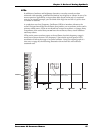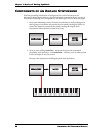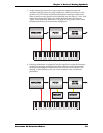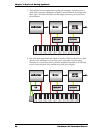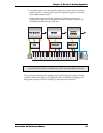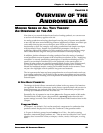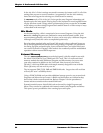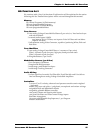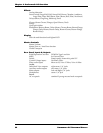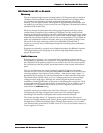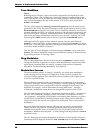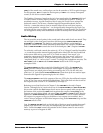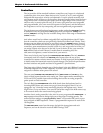
Chapter 4: Andromeda A6 Overview
ANDROMEDA A6 REFERENCE MANUAL 93
CHAPTER 4
OVERVIEW OF THE
ANDROMEDA A6
MAKING SENSE OF ALL THIS THEORY:
A
N OVERVIEW OF THE A6
Now that we’ve covered the bare-bones basics of analog synthesis, we can move on
to see how all this theory applies to the A6.
As analog synthesizer technology developed over the years, it became more feasible
to not only add more sound-modifying features (additional oscillators, two filters per
voice rather than just one, more envelopes, more LFOs, etc.) but add more
functionality as well. For example, early analog synthesizers had simpler envelopes
with just Attack, Decay, Sustain Level and Release parameters. Advances in
technology allowed the addition of a Delay portion as well as a second Decay stage
and a second Release stage for more precise articulation of envelope shaping.
In addition, further refinement of analog synthesis allows the routing of standard
sound modifiers to more elements of the sound than ever before. In fact, “modifying
a modifier” is not only possible but commonplace. Consider modulating an LFO’s
speed by an envelope or another LFO, or the keyboard, or the sustain pedal, or
dozens of other sources you wouldn’t normally think of using. Later in this manual,
we’ll explore how the A6’s audio mixing capabilities provide ways to combine
filtered and unfiltered sounds, creating an incredible wealth of new textures. These
are just a few highlights of how synthesis has grown and matured.
The A6 represents the latest and most comprehensive set of sound creation tools yet
in an analog synthesizer. You’ll find all of the necessary ingredients we just covered
plus countless more, including a full complement of studio-quality stereo effects and
external inputs.
A FEW BASIC CONCEPTS
The design of the A6 follows conventional wisdom in the way many of its functions
are organized. But that’s where many synth players, especially those who are new to
these instruments, get confused. Here, then, are a few fundamental principles that
will help you understand how the A6 is laid out.
Essentially, the A6 operates in one of two play modes: Program mode or Mix mode.
The third mode, Global, is not a play mode but a operating mode where the A6’s
master settings are made. There will be more said about Global functions later in this
Chapter.
Program Mode
In Chapter 3, we defined a Voice as the most basic component of a synthesizer that
produces sound: the physical circuitry (the “hardware”) that generates audio.
A Program is the basic group of sound settings for a Voice – the pitch or tuning,
harmonic content and shape, loudness, etc. – that are used to create the Voice’s tonal
identity: does it sound like a flute, a trumpet, a violin, a truck, a helicopter, or a dog
bark?





